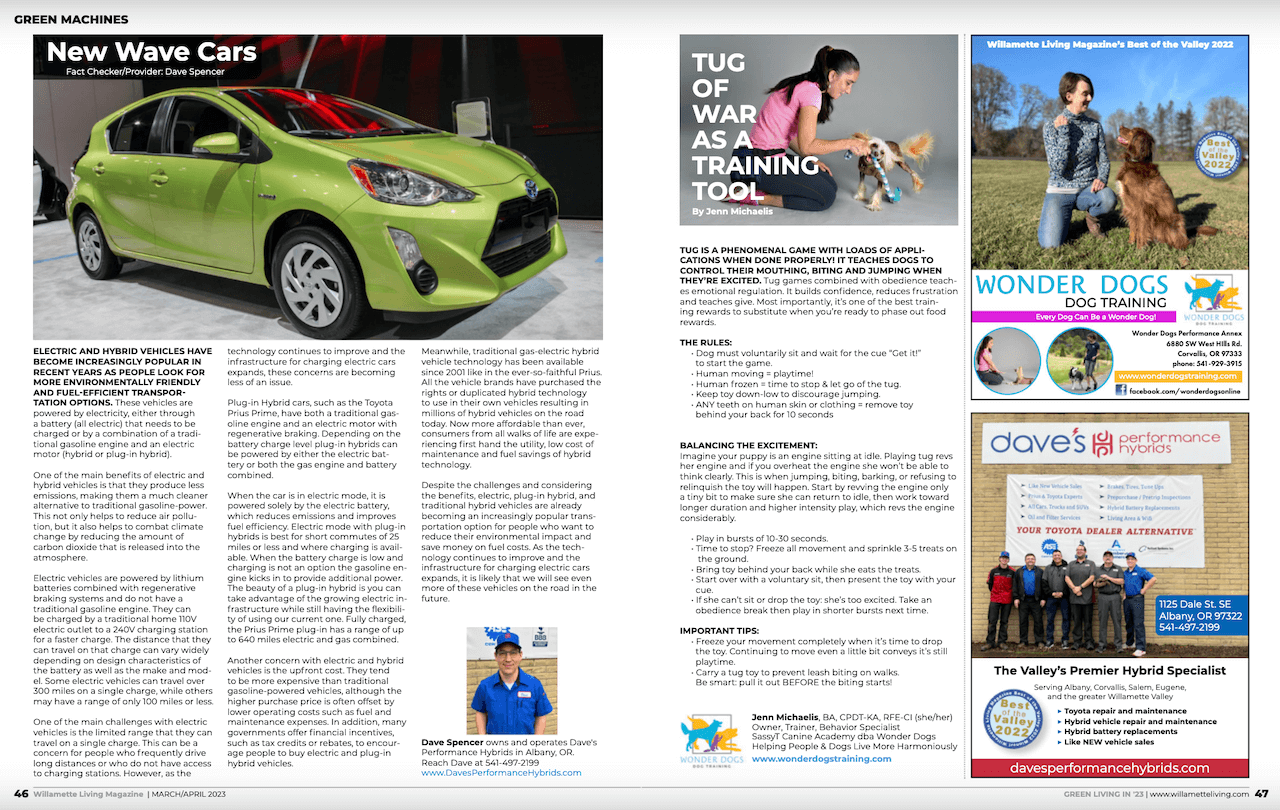We are proud to say that Dave’s Performance Hybrids was featured in Willamette Living Magazine in the March/April edition!
Reposted by Permission. Link to article here.
ELECTRIC AND HYBRID VEHICLES HAVE BECOME INCREASINGLY POPULAR IN RECENT YEARS AS PEOPLE LOOK FOR MORE ENVIRONMENTALLY FRIENDLY AND FUEL-EFFICIENT TRANSPORTATION OPTIONS. These vehicles are powered by electricity, either through a battery (all electric) that needs to be charged or by a combination of a traditional gasoline engine and an electric motor (hybrid or plug-in hybrid).
One of the main benefits of electric and hybrid vehicles is that they produce less emissions, making them a much cleaner alternative to traditional gasoline-power. This not only helps to reduce air pollution, but it also helps to combat climate change by reducing the amount of carbon dioxide that is released into the atmosphere.
Electric vehicles are powered by lithium batteries combined with regenerative braking systems and do not have a traditional gasoline engine. They can be charged by a traditional home 110V electric outlet to a 240V charging station for a faster charge. The distance that they can travel on that charge can vary widely depending on design characteristics of the battery as well as the make and mod- el. Some electric vehicles can travel over 300 miles on a single charge, while others may have a range of only 100 miles or less.
One of the main challenges with electric vehicles is the limited range that they can travel on a single charge. This can be a concern for people who frequently drive long distances or who do not have access to charging stations. However, as the technology continues to improve and the infrastructure for charging electric cars expands, these concerns are becoming less of an issue.
Plug-in Hybrid cars, such as the Toyota Prius Prime, have both a traditional gasoline engine and an electric motor with regenerative braking. Depending on the battery charge level plug-in hybrids can be powered by either the electric battery or both the gas engine and battery combined.
When the car is in electric mode, it is powered solely by the electric battery, which reduces emissions and improves fuel efficiency. Electric mode with plug-in hybrids is best for short commutes of 25 miles or less and where charging is available. When the battery charge is low and charging is not an option the gasoline engine kicks in to provide additional power. The beauty of a plug-in hybrid is you can take advantage of the growing electric infrastructure while still having the flexibility of using our current one. Fully charged, the Prius Prime plug-in has a range of up to 640 miles electric and gas combined.
Another concern with electric and hybrid vehicles is the upfront cost. They tend to be more expensive than traditional gasoline-powered vehicles, although the higher purchase price is often offset by lower operating costs such as fuel and maintenance expenses. In addition, many governments offer financial incentives, such as tax credits or rebates, to encourage people to buy electric and plug-in hybrid vehicles.
Meanwhile, traditional gas-electric hybrid vehicle technology has been available since 2001 like in the ever-so-faithful Prius. All the vehicle brands have purchased the rights or duplicated hybrid technology to use in their own vehicles resulting in millions of hybrid vehicles on the road today. Now more affordable than ever, consumers from all walks of life are experiencing first hand the utility, low cost of maintenance and fuel savings of hybrid technology.
Despite the challenges and considering the benefits, electric, plug-in hybrid, and traditional hybrid vehicles are already becoming an increasingly popular transportation option for people who want to reduce their environmental impact and save money on fuel costs. As the technology continues to improve and the infrastructure for charging electric cars expands, it is likely that we will see even more of these vehicles on the road in the future.



